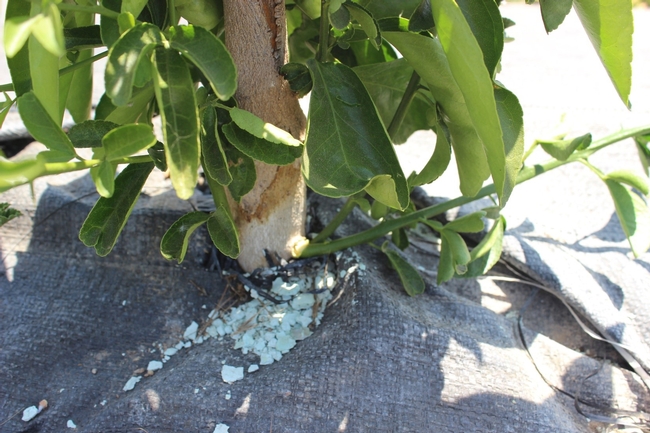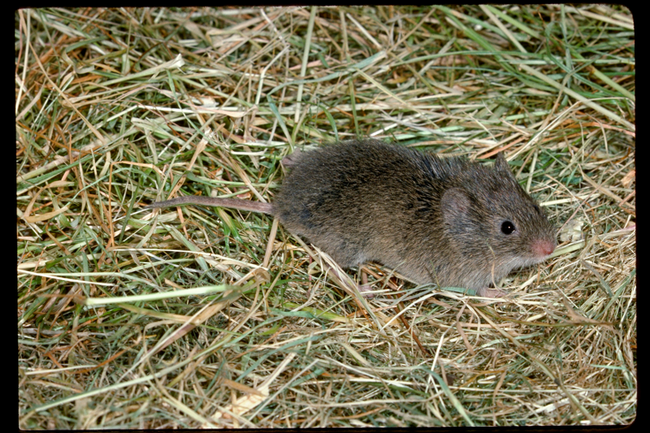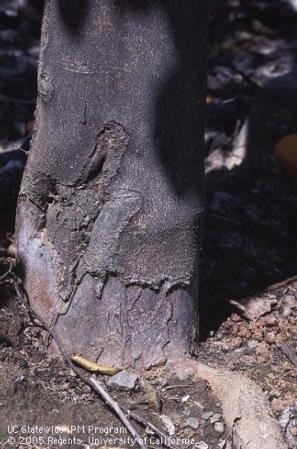
Posts Tagged: bark
Watch Out for Those Rodents - They are After Your Trees
redcThe hills have been dry for a long time, and the long dry fall is bringing animals into the avocado groves that normally stay out in the hills. They want the green cambium of trees and the moisture it provides. And especially rodents will have a field day in the well-maintained orchards.
Gophers are not usually a problem in mature avocados. They will often chew the bark below ground. Ground squirrels when they get hungry can go after just about any part of the tree, trunk branches and fruit. Voles or meadow mice will go after bark about 2 inches above ground. Rabbits can take out bark up to a foot above ground. This bark damage often leads to the yellowing of the canopy and if damage is extensive enough, wilting of the canopy. Growers don't normally see the damage until they see the wilted tree and start looking for the problem. If healing along the margins of the damage is occurring, it means it was damage that was done previously. If margins are still ragged, it means the beasts are still enjoying the tree. Trapping, poisons and a busy Jack Russell terrier are all effective, especially if used together. Voles especially like mulch around the base of the tree, and should be pulled away a foot to 18 inches. They make tunnels thought the mulch which then becomes a diagnostic for identifying the cause.
It's not just avocados that are ravaged by these animals. Citrus is like candy to them and then there's all those acres and acres of almonds that have been planted.
Avocado canopy collapse. Why? Check the tree out. See the red squirrel feeding stations in the background?
Damage that is healing over.

avocado collapsing

avocado rodent damage 2
Entomological Association of Southern California Quarterly Meeting

The Entomology Association of Southern California will be holding a quarterly meeting at the Los Angeles Arboretum. These meetings address a variety of entomological related subjects relevant to local and state pest issues and are a great way to meet and share information with other individuals who are interested in this area of science.
Presentations on:
- Bark beetle-caused tree mortality and risk following various management regimes in south California.
- Polyphagous Shot Hole Borer/Fusarium dieback: Recognizing symptoms and removing hosts.
- Observations on the control of bark boring and other wood boring beetles in landscape trees.
- Polyphagous Shot Hole Borer - a voracious Ambrosia Beetle threatening California's crops and native plants.
- Environmental effects on Polyphagous Shot Hole Borer.
- Influence of air pollution on bark beetle outbreaks.
This association has an annual membership fee of $45. Memberships cover annual registration for all four quarterly meetings in December, March, June and September.
If you are interested in attending:
Date: September 9, 2014
Time: 9:00 am - 4:00 am
Location:
Los Angeles Arboretum
301 North Baldwin Ave.
Arcadia, CA
Contact: Dr. Jim Downer, 805-645-1458 or ajdowner@ucanr.edu
Vole Damage in Citrus Revisited
Since the first publication of this article on vole damage in citrus, a recent field observation regarding vole activity is worth noting. Voles prefer a situation where there is cover and shelter generally from weed or grass. In some orchards established in the last few years a plastic strip has been installed along the tree row for weed management (Fig 1). These strips appear to be offering a sheltered environment for vole activity in some cases (Fig 2). Recent observations in two such installations, one a block planted in 2013 and the other an eight year old planting exhibited significant vole activity. The young orchard at this point does not exhibit obvious tree damage although active tunneling is apparent (Fig 3). In the older orchard feeding damage to the trunks is very obvious (Fig 4).
Meadow Mice (Voles) can cause serious damage in a citrus orchard resulting in partial or complete girdling of a tree (Fig 5). Trees often exhibit damage to the bark of the tree from the soil line up 6-8 inches (Fig. 6 ). On close inspection, an open hole 1-1.5 inches in diameter may be found at the base of the tree (Fig 7).
Five species belonging to the genus Microtus are found in California, two of which “Microtus californicus” and “M.montanus” are reported to cause damage. Damage has been reported in permanent pasture, alfalfa, hay, artichokes, Brussels sprouts, carrots, cauliflower, potatoes, sugar beets, tomatoes, grains, nursery stock and the bark of apple, avocado, citrus, cherry and olive trees.
Microtus are often found where there is grass cover. They generally do not invade cultivated crops until the crop is tall enough to provide food and shelter. Meadow mice are active all year round. They forage at any time during the day or night but are chiefly nocturnal. They are usually found in colonies marked by numerous 2-- inch wide surface runways though matted grass. Small brownish fecal pellets and short pieces of grass stems along the runways are evidence of activity. The burrows consist of extensive underground tunnels, nest chambers and storage chambers. Home range is typically small, less than a 60 foot radius in the case of “M.californicus”. All meadow mice swim well. Therefore, irrigation ditches will not serve as effective barriers against meadow mice movement into fields. Meadow mice may forage beyond the sheltered runways. Food consists of tubers, roots, seeds, grain, and succulent stems and leaves.
Females breed at 4 to 6 weeks of age with litter size of “M.californicus” averaging around 4. Under natural conditions a female Microtus may produce from 5 to 10 litters a year. The major breeding season corresponds with the season of forage growth. Microtus populations build up to a peak every 3 to 4 years, followed by a rapid decline during the next breeding season. The exact causes of the cycle of buildup and decline are not known, though disease, food shortages, physiological stress from overcrowding, and other factors may be involved. It is assumed that in cultivated areas Microtus populations are permanently based in favorable habitat such as roadsides, canal banks or adjacent noncultivated land. Invasion of cultivated cropland occurs when the population builds up or when the wild habitat becomes unfavorable. Coyotes, badgers, weasels, snakes, hawks, owls, herons and gulls are among the principal predators. It is believed that predators are not able to prevent or control a population eruption because of the birth rate of the fast breeding Microtus population. Meadow mice are classified as nongame mammals by the California Fish and Game Code. Nongame mammals, which are found to be injuring growing crops may be taken at any time or in any manner by the owner/management. The most effective management options in an orchard situation are a reduction in ground cover and the use of toxic baits. Meadow mice are cover dependent. In situations where cover removal is not possible or is insufficient to solve the problem, the next best option is the use of toxic baits. Many bait carriers are used (e.g., oat groats, wheat bait). Baits: Crimped oat groats are the most satisfactory bait although crimped whole oats are used (e.g., oat groats, wheat grains, pelletized formulations, etc., but crimped oat groats have typically been most effective). The primary toxicants used for meadow mouse control include zinc phosphide, diphacinone, and chlorophacinone. Directions for management including baiting can be obtained by contacting the Agricultural Commissioner's Office. * Portions taken from J.P.Clark Vertebrate Pest Control

vole 1

vole 2

vole 3

vole 4

vole 5

vole 6

vole 7
Decline of Coast Live Oak Trees in Southern California Is Due to Fungus
We've been getting reports of coast live oak decline along the coast, well, here's one of the causes:
RIVERSIDE, Calif. — A fungus associated with the western oak bark beetle is causing a decline in coast live oak trees in Southern California by spreading “foamy bark canker disease.”
“We have found declining coast live oak trees throughout urban landscapes in Los Angeles, Orange, Riverside, Santa Barbara, Ventura and Monterey counties,” said Akif Eskalen, an assistant specialist in cooperative extension in the Department of Plant Pathology and Microbiology at the University of California, Riverside.
Eskalen recovered the fungal species, Geosmithia pallida, from tissues of infected coast live oak trees and performed pathogenicity tests on it in his laboratory at UC Riverside. The tests showed that the fungus is pathogenic to coast live oak seedlings and produces symptoms of foamy canker.
The western oak bark beetle, which spreads the fungus, is a small beetle — about 2 millimeters long — that burrows through the bark of the coast live oak tree, excavating shallow tunnels under the bark across the grain of wood. Brown in color, this beetle is native to California. Female beetles lay their eggs in the tunnels. It is not known at this time if the beetle infects trees other than coast live oak trees.
Symptoms of foamy bark canker disease include wet discoloration on the trunk and main branches of the infected coast live oak tree. This discoloration surrounds the entry holes that the western oak bark beetle makes to burrow into the tree. Multiple holes can often be seen on an infected tree.
“When you peel back the outer bark of the infected area, you see bark (phloem) necrosis surrounding the entry hole,” Eskalen said. “As the disease advances, a reddish sap may be seen oozing from the entry hole, followed by a prolific foamy liquid. This foamy liquid, the cause of which remains unknown, may run as far as two feet down the trunk.”
Eskalen explained that when the infection is at an advanced stage, the coast live oak tree dies. Currently, no control methods are in place to control the fungus or the beetle.
If you suspect your coast live oak tree has the symptoms described above, please contact your local farm advisor, pest control advisor, county agricultural commissioner's office or Eskalen at akif.eskalen@ucr.edu.

foamy bark oak
